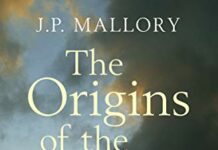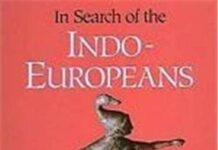
Ebook Info
- Published: 2006
- Number of pages: 1248 pages
- Format: PDF
- File Size: 3.83 MB
- Authors: J. P. Mallory
Description
This book introduces Proto-Indo-European and explores what the language reveals about the people who spoke it. The Proto-Indo-Europeans lived somewhere in Europe or Asia between 5,500 and 8,000 years ago, and no text of their language survives. J. P. Mallory and Douglas Adams show how over the last two centuries scholars have reconstructed it from its descendant languages, the surviving examples of which comprise the world’s largest language family. After a conciseaccount of Proto-Indo-European grammar and a consideration of its discovery, they use the reconstructed language and related evidence from archaeology and natural history to examine the lives, thoughts, passions, culture, society, economy, history, and environment of the Proto-Indo-Europeans. Ourdistant ancestors had used the wheel, were settled arable farmers, kept sheep and cattle, brewed beer, got married, made weapons, and had 27 verbs for the expression of strife. The subjects to which the authors devote chapters include fauna, flora, family and kinship, clothing and textiles, food and drink, space and time, emotions, mythology, religion, and the continuing quest to discover the Proto-Indo-European homeland.Proto-Indo-European-English and English-Proto-Indo-European vocabularies and full indexes conclude the book. Written in a clear, readable style and illustrated with maps, figures, and tables, this book is on a subject of great and enduring fascination. It will appeal to students of languages, classics, and the ancient world, as well as to general readers interested in the history of language and of early human societies.
User’s Reviews
Reviews from Amazon users which were colected at the time this book was published on the website:
⭐In 26 chapters, each with a helpful “Further Reading” section, Mallory and Adams offer a thorough survey of the current status of Proto-Indo-European (PIE) studies. In their introduction they acknowledge the example of Buck’s A Dictionary of Selected Synonyms in the Principal Indo-European Languages, asserting that they “have indeed aimed to do for Proto-Indo-European something of what Buck did for the individual Indo-European languages,” and they succeed. Therefore, readers looking for detailed analyses of – for instance – the current state of knowledge about the PIE verb, the most complex part of the language, will find themselves disappointed. But then such readers already know which journals to read to follow current debates at the cutting edge, and the ample bibliographies here will also serve them well. Glottalic theory, to pick another favorite sticking point, likewise receives brief treatment, but with a balanced observation typical of the book’s treatment of differing theories as a whole: “Fortunately, one can interchange the reconstructed forms between the traditional system and the variety of newly proposed systems in a relatively mechanical fashion. The traditional system is understood by all, and until the weight of scholarly opinion dismisses it for a single new system … it remains the one most often cited.” Nineteen chapters, the heart of the text, focus on the larger PIE world, with word lists, helpful summary charts and detailed discussion of semantic fields for clothing, religion, physical actions, relationships, food and drink, speech and sound, anatomy, and so on. The over 250 pages of appendices and indices, including a lexicon of some 2000 Proto-Indo-European roots (with both English-PIE and PIE-English sections), alone make this volume worth owning. As a challenging text for undergrad linguistics majors, or an excellent and readable survey for grad students in other fields, as well for as the general reader interested in linguistic and cultural reconstruction, this text will serve admirably.
⭐The first thing I want to say about this book is if you don’t want a detailed discussion of Language as opposed to history then this book is not for you. However, since this was one of the things I was looking to study it was perfect for me.The book covers the following main ideas:(1) Concise introductions to the discovery and composition of the Indo-European language family.(2) The way the proto-language has been reconstructed.(3) Its most basic grammar(4) The interrelationships between the different language groups(5) The temporal position of the Indo-European languages(6) Some of the difficulties in reconstructing a proto-language.(7) Semantic field of the Proto-Indo-European lexicon.(8) An examination of mythology and possible homelands of the Proto-Indo-Europeans.For me the most interesting chapters were the last two, as they talked about the mythology and religion and how they can be reconstructed, and the possible homelands of the Proto-Indo Europeans. Its amazing what you can get from the words of a language!
⭐I shelled out 50 for this tomb because I wanted to read just one book about proto indo european. I’m not a linguistic, I’m really not even interested in indo european but I just felt like I needed to know what was going on in this field. Well, mission accomplished. At times dryly funny, often dry and unfunny, this Introduction left me satisfied that I had the bare outlines of this field of linguistics covered. Much of the book is broken into topics “plants” “animals.” These chapters were occasionally illuminating but often just boring and at times I skimmed through. The real pay off is the end when they do a chapter on comparative mythology and tackle the “home land” problem of indo european studies. I suppose I would have liked less… well… linguistics, and more commentary on the foibles of the indo european academic community, but hey, Oxford knows what it’s doing. I very much doubt I will be reading another book on linguistics in the next five to ten years, but I’m glad I read this one.
⭐The Oxford Introduction to Proto-Indo-European is not only the most comprehensive review of the subject but also the clearest and most nuanced discussion I have read.
⭐It’s hard to understand what audience a book like this is aimed toward. Yes, it’s from a university press, so one assumes an academic audience of some kind. But the level of writing is much too light, fun, and enjoyable to be aimed at only people earning credit toward degrees or trying to make tenure. I’m doing neither of those actions but enjoyed the hell out of this book. But I wonder whether the authors were being mischievous or dismissive when they write something like, “In addition to standard indexes, the book also contains two word lists: a Proto-Indo-European English list and a list of the Proto-Indo-European vocabulary arranged by its English meaning (which should at least facilitate those who delight in such tasks as translating Hamlet into Klingon).” Eh, anyway, it’s a fun book if you embrace your love of learning and shut away the voices of anti-intellectualism.
⭐Ordered this book for my 11 th grade Gradaughter. She was thrilled with it. Arrived in perfect shape.
⭐A lot of this is pretty heavy going for the non-specialist, but even so is very interesting. I am always doubtful of the soundness of anyone who can write ‘is comprised of’, not to mention various other bits of unFowlerish English.
⭐A disappointment. Good book, but not sufficiently advanced, aimed more toward undergraduates than advanced students or scholars already fully acquainted with the essential knowledge of the basics of the field.
⭐I bought this to get an overview of thinking on the subject. I didn’t expect it to be such a fine read. Of course is is heavy going but there are far more beautifully crafted sentences in this book than I had any reason to expect. There are even places I laughed out loud (but I’m probably weird).The author has a precise understanding of the different audiences who might come to the book and has structured it to meet their needs. It is a model for such endeavours.
⭐Absolutely packed with detailed reconstructions of PIE words arranged in topic-based chapters, this is a fantastic and comprehensive introduction to the subject. The introductory chapters offer valuable background on trends in the field, and the authors adopt a sober and unbiased style in navigating through the various theories that have shaped PIE linguistics. Much detail is paid to the isoglosses which support the various reconstructions, and ample word lists make the volume not only an introduction but a great reference tool.Aimed primarily at the academic reader, there is also plenty of material that the casual linguist will find fascinating here too, and the style is accessible to all, although some knowledge of linguistics would help in the introductory chapters. All in all, a thoroughly recommended book.
⭐This is a fascinating book but it is really aimed at the specialist with a background in linguistics and not at the general reader. I think Mallory’s other book on the Indo-Europeans is much more accessible for anyone lacking a background in the subject. Why have I given it five stars then? I think that for the right person, for the reader who has a great interest in this subject and some background in linguistics, this is a perfect introduction. It is a monumental work of scholarship and they deserve the five stars but if you are a general reader with only a passing interest in these matters, this probably isn’t the book for you.
⭐This is a quite invaluable introduction to a topic of huge importance but equally of ve great technical difficulty for those of us who, in the words of the distinguished Hellenist Martin West, are not ‘black belts’ in the subject, which to many seems the study of the ‘unreadable in the pursuit of the unpronouncable’ We are guided through the topic by language group, but also by analyses of themes in language – food, war, etc., which give the reader a true sense of how we Indo-Europeans spread our language and culture across Europe and much of Asia- and eventually virtually the entire American continent.
⭐My son studies languages so this was a gift for him. There is an actual dictionary in the book which is one of the things he was looking for.Thank you.
Keywords
Free Download The Oxford Introduction to Proto-Indo-European and the Proto-Indo-European World (Oxford Linguistics) in PDF format
The Oxford Introduction to Proto-Indo-European and the Proto-Indo-European World (Oxford Linguistics) PDF Free Download
Download The Oxford Introduction to Proto-Indo-European and the Proto-Indo-European World (Oxford Linguistics) 2006 PDF Free
The Oxford Introduction to Proto-Indo-European and the Proto-Indo-European World (Oxford Linguistics) 2006 PDF Free Download
Download The Oxford Introduction to Proto-Indo-European and the Proto-Indo-European World (Oxford Linguistics) PDF
Free Download Ebook The Oxford Introduction to Proto-Indo-European and the Proto-Indo-European World (Oxford Linguistics)

